Common menu bar links
Breadcrumb Trail
ARCHIVED - Veterans Affairs Canada - Report
 This page has been archived.
This page has been archived.
Archived Content
Information identified as archived on the Web is for reference, research or recordkeeping purposes. It has not been altered or updated after the date of archiving. Web pages that are archived on the Web are not subject to the Government of Canada Web Standards. As per the Communications Policy of the Government of Canada, you can request alternate formats on the "Contact Us" page.
Section II: Analysis of Program Activities by Strategic Outcome
This section presents Veterans Affairs Canada's performance against the expected results identified in the 2010-11 Report on Plans and Priorities.
Strategic Outcome #1 - Eligible Veterans and other individuals achieve their optimum level of well-being through programs and services that support their care, treatment, independence and re-establishment
Program Activities
- Compensation and Financial Support and
- Veterans Health Care and Re-establishment
Spending Breakdown by Program Activity 2010-11
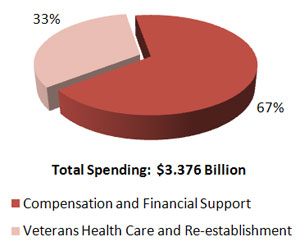
To ensure the continued well-being of Veterans and their families after release from service, VAC provides access to programs and services aimed at meeting their physical health, mental health and financial needs.
In 2010-11, VAC was able to exceed some of its performance targets in both existing and new performance indicators.
- In 2010, 83% of eligible Veterans and other individuals reported they were "satisfied" or "very satisfied" with their life in general (Source: 2010 National Client Survey)
- In addition, other indicators found that the vast majority of Veterans and other individuals were satisfied with their housing (93%), family relationships (91%), financial situation (80%) and main job or activity (68%). (Source: 2010 National Client Survey)
- In 2011, Statistics Canada found a significantly lower risk of death from all causes in the released Canadian Forces population, compared with the general population. (Source: Canadian Forces Cancer and Mortality Study)
- 82% of Veterans and other individuals served by VAC reported positive mental health—exceeding the target of 70%—the self-reported mental health of Veterans is still low compared to the Canadian population. (Source: 2010 National Client Survey)
- In 2010, only 46% of CF Veterans receiving benefits and services from VAC who were released during this period reported "excellent" or "very-good" mental health, compared to 75% of Canadians in the general population. (2010 Survey on Transition to Civilian Life)
- Eligible Canadian Forces Veterans reported lower rates of low income than the general population by household size. (Source: Survey on Transition to Civilian Life and Statistics Canada before-tax Low Income Measure (LIM))
Strategic Outcome #1 Highlights
- 24,279 decisions were made on first applications for disability benefits during the 2010-11 fiscal year. (15,496 decisions for disability awards - 8,783 decisions for disability pensions)
- 1,590 eligibility decisions were rendered on first applications for the Rehabilitation Program during the 2010-11 fiscal year.
- 738,241 calls were answered by the NCCN during the 10-11 fiscal year.
- As of March 31, 2011, there were 14,111 Veterans receiving disability compensation for a psychiatric disability, with 70% of them involving post-traumatic stress disorder.
- 11,909 cases were completed by the Bureau of Pensions Advocates.
Financial Resources and Human Resources
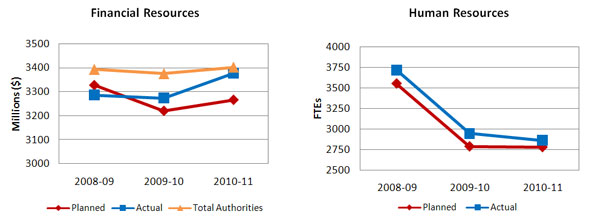
Program Activity 1.1 - Compensation and Financial Support
Sub Activities:
- Disability and Death Compensation
- Financial Support
- Bureau of Pension Advocates
Veterans Affairs provides, upon eligibility, pensions or awards for disability or death and financial support as compensation for hardships arising from disabilities and lost economic opportunities.
Veterans Affairs has a comprehensive and integrated range of compensation and wellness programs to support Veterans and other individuals served by VAC. This includes: Veterans of the Second World War and the Korean War, Merchant Navy Veterans, Canadian Forces Veterans, Canadian Forces members, spouses, common-law partners, certain civilians, and survivors and dependants of military and civilian personnel.
Veterans Affairs also administers disability pensions for the Royal Canadian Mounted Police under a Memorandum of Understanding.
This Program Activity is delivered through operating and grants.
Program Activity 1.1 Snapshot
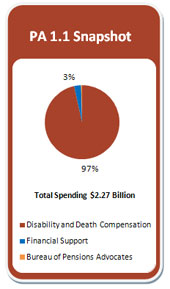
| Planned Spending | Total Authorities | Actual Spending |
|---|---|---|
| 2,125.1 | 2,264.5 | 2,269.8 |
| Planned | Actual | Difference |
|---|---|---|
| 925 | 1,001 | (76) |
| Expected Results |
Performance Indicators |
Targets | Performance Status |
|---|---|---|---|
| Eligible Veterans and other individuals are able to meet their basic living expenses. | Percentage of eligible Veterans and other individuals who are able to meet their basic living expenses. | 70% | Exceeded |
| Eligible Veterans and other individuals feel the extent and impact of their service-related disability has been recognized by VAC. | Percentage of eligible Veterans and other individuals who feel the disability benefits received from VAC recognizes their service-related disability. | 60% | Exceeded |
Performance Summary and Analysis
Research has shown that income is an important indicator of health. In addition to disability compensation, VAC provides financial support to eligible Veterans and survivors to ensure their income meets their basic needs.
- The vast majority (94%) of eligible Veterans and other individuals reported their income met their basic living expenses or better (Source: 2010 National Client Survey)
- 80% of survey respondents said they were satisfied with their financial situation. Satisfaction ratings were highest among war service Veterans at 87%, while Canadian Forces Veterans rated their level of satisfaction at 76%. In comparison, the overall rate of satisfaction with their financial situation among serving Regular Force members in 2005 was 73%. (Source: 2010 National Client Survey)
- Overall, Veterans are less likely to experience low income than the general population (Source: 2010 Survey on Transition to Civilian Life)
- As of March 31, 2011, VAC was providing monthly disability pensions and lump sum awards to 188,716 Veterans and other individuals.
- Focus groups conducted with Veterans in 2005—part of an evaluation of disability pensions—found that recipients viewed their disability compensation with pride and dignity.
- Overall, 74% of Veterans receiving disability benefits felt their disability benefits recognized their service-related disability. War Service Veterans were more likely to report perceived recognition for service-related disabilities at 88%, than were Canadian Forces Veterans at 63%. (Source: 2010 National Client Survey)
Other Notable Achievements
- Reduced the average turnaround-time for rendering decisions on Disability Benefit applications from 24 weeks to 16 weeks.
- 73% of applicants received a favourable decision.
- September 2010, the Government of Canada announced increased financial support for seriously injured Veterans.
- October 2010, the Government of Canada announced action taken to improve and speed up support for Veterans suffering from amyotrophic lateral sclerosis (ALS).
- December 2010, the Government of Canada modified eligibility criteria and extended the time that individuals had to submit an application for the Agent Orange exgratia payment
Lessons Learned
What worked well
In 2010–11, the Department contributed to the overall Strategic Outcome by improving the quality of services. Experts have been engaged to streamline processes and simplify program delivery. The Department has been cutting red tape to provide faster more effective and hassle-free service to the men and women it cares for and supports.
With VAC's changing demographics and new opportunities in social media tools, the Department was able to provide Canadians with more opportunities to interact with Veterans Affairs Canada about their programs and services.
Additionally, the Department worked closely with the Canadian Forces and Department of National Defence to improve the New Veterans Charter (NVC) programs. These changes will see the Department establish a minimum, pre-tax income of $40,000 a year for Veterans receiving the Earnings Loss benefit. Additionally, it expands eligibility for the Permanent Impairment Allowance (PIA) and the Exceptional Incapacity Allowance (EIA); introduces a new $1,000 monthly supplement to the PIA allowance to help the most seriously injured or ill Veterans who cannot be gainfully employed; and create new payment options for the Disability Award.
As well, the Bureau of Pensions Advocates maintained an average turnaround time of 11 weeks, as compared with 24 weeks in 2008-2009, from contact with the Bureau, to scheduling of the case before the Veterans Review and Appeal Board. Business process reviews were also conducted in seven of the Bureau's 14 offices, which helped identify and resolve issues that could have had an impact on service efficiencies.
What could be improved
Phases II and III of the NVC evaluation identified areas where improvements could be made to the design and delivery of programs. Findings included the need to collect appropriate data to better measure value-for-money; to place more focus on families within programs; to change the Rehabilitation Program to reflect those Veterans requiring long term support; and to review the Career Transition Program to ensure it offers value-for-money.
The evaluations also identified areas for operational improvements, particularly the need for service staff to better understand the roles and responsibilities of specialists who provide technical advice and program guidance. It also outlined the need for service staff to receive nationally coordinated, skills-based training and improved access to up-to-date policies and business processes. Each evaluation recommendation has been accepted and targeted action plans developed to address the issues.
Program Activity 1.2 - Veterans Healthcare and Re-establishment
Sub Activities:
- Long Term and Nursing Home Care
- Health Care Benefits and Other Re-establishment Services
- Home Care and Other Veterans Independence Program Services
Veterans Affairs Canada provides health benefits, a Veterans Independence Program, long- term care and rehabilitation and re-establishment support to eligible Veterans and others. The Health Care Program is designed to enhance the quality of life of Veterans and other individuals served by VAC, promote independence, and assist in keeping Veterans and other individuals at home and in their own communities by providing a continuum of care.
This Program Activity is delivered through operating resources and contributions.
Program Activity 1.2 Snapshot
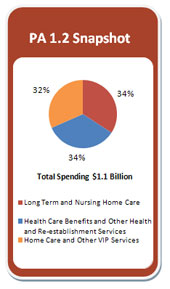
| Planned Spending | Total Authorities | Actual Spending |
|---|---|---|
| 1,141.0 | 1,136.7 | 1,106.2 |
| Planned | Actual | Difference |
|---|---|---|
| 1,853 | 1,856 | (3) |
| Expected Results |
Performance Indicators |
Targets | Performance Status |
|---|---|---|---|
| Eligible Veterans and other individuals have their health care needs met. | Percentage of eligible Veterans and other individuals who report "good", "very good", or "excellent" health. | 60% | Mostly met |
| Eligible Veterans and other individuals actively participate in the civilian workforce. | Percentage of eligible Veterans and other individuals who actively participate in the civilian workforce (unless totally disabled or retired). | 70% | Exceeded |
| Eligible Veterans and other individuals actively participate in the civilian workforce. | The unemployment rate of Canadian Forces Veterans will not exceed that of the general population. | Unemployment rate of CF Veterans is equal to or less than that of the general population. | Exceeded |
| Eligible Veterans and other individuals actively participate in, or are integrated into their communities. | Percentage of eligible Veterans and other individuals who report a "somewhat strong" or "very strong" sense of community. | 50% | Exceeded |
Performance Summary and Analysis
Research demonstrated that individuals with chronic health conditions generally report poorer health and that self-reported health declines with age.
- Overall, 52% of eligible Veterans and other individuals self-reported their health as "good", "very good" or "excellent", falling short of the established target of 60%. (Source: 2010 National Client Survey)
- Canadian Forces Veterans released from service between 1998 and 2007 who were receiving benefits from VAC self-assessed their health much lower than a comparable group within the general population—only 28% of eligible Canadian Forces Veterans reported their health as "very good" or "excellent", compared to 61% of other Canadians. (Source: 2010 Survey on Transition to Civilian Life)
- 62% of eligible Veterans and other individuals reporting that their sense of community belonging was "very strong" or "somewhat strong", exceeding the target of 50%. (Source: 2010 National Client Survey). From this, it was also noted that Canadian Forces Veterans released from service between 1998 and 2007 reported their sense of community belonging at 52%, which was lower than the 62% found within the general population as noted in the 2010 Survey on Transition to Civilian Life.
Employment has been found to promote one's physical, mental and social well-being3.
- The 86.5% employment rate experienced by Canadian Forces Veterans released from service between 1998 and 2007, was comparable to that of the general population. (Source: 2010 Survey on Transition to Civilian Life)
Other Notable Achievements
- 24 integrated personnel support centres are now operational across the country.
- The standard turnaround time for decisions on rehabilitation eligibility was reduced from 4 weeks to 2 weeks.
- 20 new case managers were added across the country.
- Veterans who receive support under the Veterans Independence Program now have access to direct deposit and no longer have to sign a form every time a change is made to their services.
- 190 organizations that provide support to the homeless and "hard to house" were contacted to inform them of services and benefits offered by VAC.
Lessons Learned
What worked well
In 2010−11, Partnerships with organizations such as the International Society for Traumatic Stress Studies and working through VAC’s own National Centre for Operational Stress Injuries, allowed VAC to participate in information sharing activities and to increase it ’s exposure to the latest evidence in assessing and treating operational stress injuries.
Work undertaken to provide tele-health systems at all 10 clinics in the VAC-funded OSI clinic network allowed the Department to enhance its services to Veterans and other individuals in places where OSI clinics did not previously exist. While technical/regulatory issues continue in some jurisdictions, by the last quarter of 2010−2011, more than 6% of Veterans were using the systems to provide clinical intervention services.
What could be improved
The Department acted swiftly and appropriately in cancelling the Request for Proposals for the new Federal Health Claims Processing System (FHCPS) in March 2011 after it was determined that changes resulting from VAC’s Transformation Agenda would have a significant impact on the requirements for the new FHCPS contract.
An interdepartmental governance committee has been established to review options and will improve the Request for Proposal for the FHCPS in order to secure procurement by 2015.
Strategic Outcome #2 - Canadians remember and demonstrate their recognition of all those who served in Canada's efforts during war, military conflict and peace
Program Activities
- Remembrance Outreach
- National and International Memorials
Generations of Canadian Veterans, through their courage, determination and sacrifice have helped to ensure that Canadians live in a free and peaceful country. Remembering their contributions depends largely on a Canadian population that actively acknowledges Veterans' achievements and sacrifices through remembrance-based activities.
The Department's Strategic Outcome 2 continues to exceed its target, more than 11 million Canadians participating in remembrance in 2010-11. The results have remained consistent over the past few years.
- The vast majority of Canadians (91%) agree that Canada's veterans should be recognized for their sacrifices. (Source: November 2010 Attitudes Towards Remembrance and Veterans' Week 2010 Omnibus Survey)
- 34% of Canadians reported having participated in a Veterans' Week activity, such as a local Remembrance Day ceremony. Of those respondents, 66% said they had made an effort to demonstrate their appreciation to Veterans in the past year. (Source: November 2010 Attitudes Towards Remembrance and Veterans' Week 2010 Omnibus Survey)
- A different survey conducted in March 2010 concluded that 46% of Canadians reported having attended a local Remembrance Day ceremony in 2009—a marked increase from the 30% results seen in Veterans' Week, 2008. (Source: Canadians' Awareness, Engagement & Satisfaction with Remembrance Programming Survey)
Spending Breakdown by Program Activity 2010-11
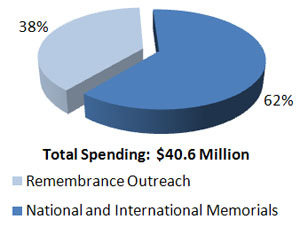
Strategic Outcome #2 Highlights
- VAC led or supported more than 870 national and international remembrance ceremonies and events in 2010-11;
- 4.7 million learning materials and promotional products, involving the recognition of all Canadian Veterans—including modern-day Veterans—were distributed;
- 79 Canadian Forces video clips were added to the Heroes Remember Web section;
- VAC's Remembrance iPhone App introduced during Veterans' Week 2010 was well received, with 4,160 downloads, as of March 31, 2011; and
- Close to one million visits to the Canada Remembers and Youth and Educators sections of VAC's Web site resulted in approximately 340,000 downloads.
Financial Resources and Human Resources
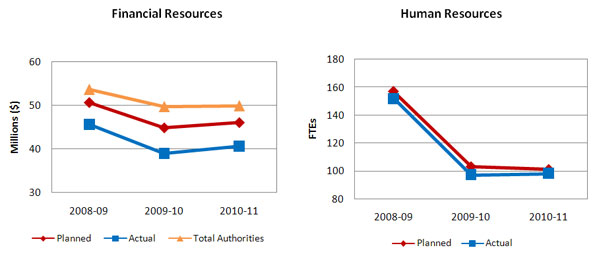
Program Activity 2.1 - Remembrance Outreach
Sub Activities:
- Information Products and Learning Initiatives
- Ceremonies and Events
- Partnerships
Remembrance Outreach is responsible for providing Canadians, especially youth, with opportunities to learn about remembrance subjects through printed and online materials and activities.
The Remembrance Outreach Program provides leadership and support to ceremonies and events, in Canada and internationally, that recognize and honour Canada's war dead and Veterans.
Through the Partnership Contribution Program, non-profit organizations are able to apply for financial assistance to undertake remembrance initiatives that extend Veterans Affairs Canada's remembrance mandate. A new initiative, corporate engagement and marketing will help the Department extend the reach and capacity of its remembrance efforts.
This activity is delivered through contributions, grants and operating resources.
Program Activity 2.1 Snapshot
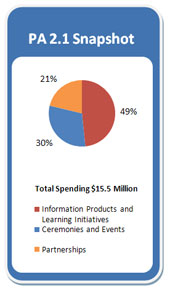
| Planned Spending | Total Authorities | Actual Spending |
|---|---|---|
| 13.7 | 17.3 | 15.5 |
| Planned | Actual | Difference |
|---|---|---|
| 78 | 76 | 2 |
| Expected Results |
Performance Indicators |
Targets | Performance Status |
|---|---|---|---|
| The memory of the achievements and sacrifices of those who served Canada in war, military conflict and peace is preserved. | Percentage of Canadians aware of the achievements and sacrifices of Canadian Veterans. | 65% | Exceeded |
Performance Summary and Analysis
Canadians are increasingly aware of the achievements and sacrifices of Canadian Veterans.
- The number of individuals who are aware of the achievements and sacrifices of Canadian Veterans remains high at 83%5. This is slightly up from the 79% noted in the March 2010 Phoenix Strategic Perspectives Inc.'s poll, Canadians' Awareness, Engagement and Satisfaction with Remembrance Programming.
- In addition to being aware, 79% of Canadians say they are proud of Canada's military role in conflicts like the First and Second World Wars, the Korean War and Afghanistan. Like previous studies, approximately 70% feel they know about the role Canada's military played in these conflicts.
Other Notable Achievements
- The 65th anniversary of the Liberation of the Netherlands was marked in May 2010 with VAC leading the overseas event and ceremonies, which included the participation of the Queen of the Netherlands, along with the prime ministers of both Canada and the Netherlands. Ceremonies were also conducted in Canada to recognize this important anniversary.
- The 65th anniversary of the end of the Second World War in Europe was marked in May and the 65th anniversary of the end of the Second World War in Asia was recognized in August with ceremonies and events in Ottawa.
- Another anniversary was remembered In August 2010—the end of the Second World War in the Far East (VJ Day)—with activities that included a remembrance ceremony with Veterans of the Burma Campaign.
- Canada Remembers has more than 500,000 active participants on Facebook, making it one of Canada's largest communities. A best practice according to Google.
Lessons Learned
What worked well
Through VAC's catalyst role, partnerships were developed and technology was used to involve Canadians and youth in remembrance. VAC connected with Canadians through social media sites, asking them "How will you remember?". This question challenged Canadians to get actively involved. Not only did Canadians take up the challenge, they shared their remembrance activities by posting videos on YouTube and other social networks for VAC and all Canadians to see.
In 2010-11, the Department took steps to ensure that all new educational materials for VAC's Web site were designed to be more interactive and appealing to youth. VAC also reached out to more than 55,000 educators and youth leaders in Canada to promote its learning resources through e-mails, meeting face-to-face at conferences and providing input to teachers' newsletters and magazines.
The Department also laid the foundation to involve the private sector in remembrance by contacting approximately 21 businesses to explore their interest in getting involved in remembrance. The response was very positive and the department plans to continue engaging the private sector to expand the culture of remembrance.
In addition, the response to the Community War Memorial Program launched in November 2010 was impressive, with 12 applications received in the last quarter of 2010-11 and 25 more in the first quarter of 2011-12. Pursuing its role as a catalyst of change, VAC continued to support communities by providing partnership funding, guidance and advice, conducting outreach activities, supplying remembrance materials and posting remembrance activities to VAC's Calendar of Events.
What worked could be improved
In 2010-11, two VAC studies: Canadian Perceptions and Attitudes around Remembrance6, and Canada Remembers: Canadian Forces Veterans – Qualitative Exploratory Research7, were analysed to evaluate whether initiatives appropriately recognized modern-day Veterans. The analysis concluded that changes are required in order to better balance VAC's remembrance programming.
In the fall of 2010, the Department hired a consultant to develop an objectives framework to guide the development of new strategies targeted to youth.
Program Activity 2.2 - National and International Memorials
Sub Activities:
- Funeral and Burial Program
- Memorials and Cemetery/Grave Maintenance
- European Operations
This activity is responsible for the delivery of funeral, burial and grave marking benefits, the preservation of memorials overseas and cemetery and grave maintenance, nationally and internationally.
VAC also has an international presence in Europe.
The administration of funeral, burial and grave marking benefits is carried out in partnership with Last Post Fund Corporation and the maintenance of war graves and Memorials throughout the world-wide is delivered in partnership with the Commonwealth War Graves Commission.
This activity is delivered through Grants and Operating resources
Program Activity 2.2 Snapshot
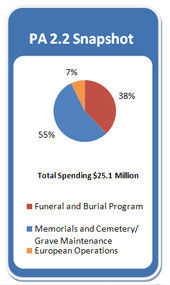
| Planned Spending | Total Authorities | Actual Spending |
|---|---|---|
| 32.4 | 32.6 | 25.1 |
| Planned | Actual | Difference |
|---|---|---|
| 23 | 22 | 1 |
| Expected Results |
Performance Indicators |
Targets | Performance Status |
|---|---|---|---|
| Canadian Veterans and war dead are recognized and honoured in death. | Percentage of Canadians satisfied with how Veterans Affairs Canada recognizes and honours war dead and Veterans in death. | 75% | Somewhat met |
Performance Summary and Analysis
Although 88% of Canadians polled in the Attitudes Towards Remembrance and Veterans' Week 2010 Omnibus Survey, think it is important for Veterans Affairs Canada to pay tribute to deceased Veterans and war dead—by maintaining memorials, cemeteries and grave markers and providing funeral and burial assistance—only 59% were satisfied with the Department's performance.
Other Notable Achievements
- In 2010-11, VAC provided assistance to 1,525 Veterans' funeral and burial expenses through the Last Post Fund;
- VAC, through the Commonwealth War Graves Commission, maintained 110,000 Canadian war dead graves;
- VAC maintained over 200,000 graves of Veterans buried in approximately 6,500 cemeteries throughout Canada.
Lessons Learned
What worked well
Major operational changes were made to the Funeral and Burial Program during the 2010-11 year. The Last Post Fund completed a strategic review at the end of 2009 and many of the recommendations were successfully implemented in 2010.
What could be improved
In 2010-11, VAC fell short of its program activity target of 75% of Canadians being satisfied with how Veterans Affairs Canada recognizes and honours war dead and Veterans in death. The Department is now aware that overall problems exist and, during the next fiscal year, will analyze the issues then fix the problem.
Improvements to the Funeral and Burial Program also continue to be a priority as the Department meets with and listens to stakeholders to understand and respond to their priorities.
Strategic Outcome #3 - Fair and effective resolution of disability pension, disability award and War Veterans Allowance appeals from Canada's war Veterans, Canadian Forces members and Veterans, Royal Canadian Mounted Police members and Veterans, qualified civilians and their families.
Program Activities
- Veterans Review and Appeal Board redress process for disability pensions and awards
VRAB is an independent, quasi-judicial tribunal that fulfills an important role within Canada's disability benefits system for Veterans, Canadian Forces members, Royal Canadian Mounted Police members and their families. Throughout the year, in approximately 30 locations across the country, members hear and make decisions on applications for review and appeal of disability decisions rendered by VAC. The Board carries out its mandate within an environment influenced by the volume of applications received and the complexity of the cases. There is a continuing change in applicant make-up, with the growing number of Canadian Forces members and Veterans and fewer traditional Veterans.
The role of Board members is to determine whether the laws governing the disability benefits programs for Veterans and other applicants have been properly applied by VAC in individual cases. To accomplish this, the Board conducts hearings, listens to applicants' testimony, interprets the rules based on current legislation and renders written decisions. The Board makes every effort to issue a fair and well-reasoned decision for each applicant.
VRAB worked to improve its program, without sacrificing quality decision-making, and actively managed its caseload to provide written decisions within the published service standard.
Spending Breakdown by Program Activity 2010-11
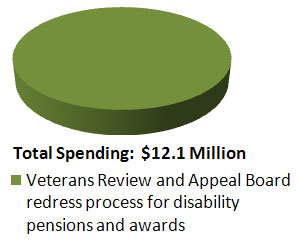
Strategic Outcome #3 Highlights
- 3,539 Review Hearing decisions
- 974 Appeal Hearing decisions
Financial Resources and Human Resources
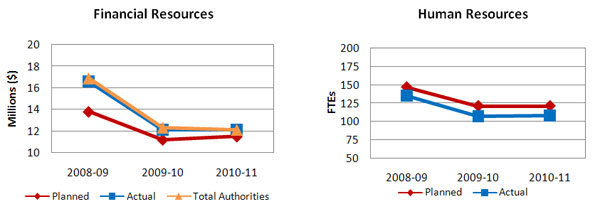
Program Activity 3.1 - Veterans Review and Appeal Board redress process for disability pensions and awards
This activity provides Canada's war Veterans, eligible Canadian Forces and RCMP members and Veterans, qualified civilians and their families with full opportunity to request review and appeal hearings to ensure a fair adjudicative process for disability pension, disability award, and War Veterans Allowance claims.
| Planned Spending | Total Authorities | Actual Spending |
|---|---|---|
| 11.4 | 12.1 | 12.1 |
| Planned | Actual | Difference |
|---|---|---|
| 121 | 108 | 13 |
| Expected Results |
Performance Indicators |
Targets | Performance Status |
|---|---|---|---|
| Veterans and other individuals receive a timely decision following their hearing. | Percentage of decisions finalized within the published service standard. | 85% | Met all |
Performance Summary and Analysis
The Board's mandate is to hear, determine and deal with applications for review and appeal of disability decisions. The volume of applications to the Board in 2010-11 was similar to 2009-10. Of the applicants who applied, the number of Canadian Forces members and Veterans had increased, compared to the volume of traditional Veterans.
Case types, such as post traumatic stress disorder and chemical exposure, have become more complex. More than 4,600 applicants received decisions as a result of an increased focus on hearing cases and issuing decisions within a shorter time period. The average time for review hearing cases—from registration with the Board to issuance of a decision —was reduced from 165 days in 2009-10 to 162 days in 2010-11. This time period also depends on the applicant's readiness and availability in the hearing schedule. The average time for appeal hearing cases increased slightly from 74 days in 2009-10 to 81 days in 2010-11. During the year, the Board reduced its pending caseload and was able to hear cases ready to proceed.
On average, 49.5% of the finalized review decisions and 33.2% of the finalized appeal decisions varied a previous ruling. The Board updated its service standard, effective April 1, 2009, and set an ambitious target to finalize 85% of its decisions within six weeks of hearings. In 2010-11, the Board surpassed its service standard target and finalized 85.3% of the 3,539 review decisions and 88.1% of the 974 appeal decisions, within six weeks of the hearings. The Board is committed to continuing this high level of performance.
Lessons Learned
What worked well
The Board implemented its five-year Strategic Plan, which identifies priorities and responds to evolving changes in case types. To address the complex nature of applications, the Board focussed on providing members and staff with specialized training on medical conditions and adjudicative issues, as well as developing the right tools. Through the use of technology, the Board provided timely hearing information to members, representatives and applicants and monitored workload more effectively.
What could be improved
To respond to the diverse and changing needs of applicants and the transformation exercise being undertaken by VAC, the Board initiated a Process Redesign Project. This undertaking will include a review of VRAB's processes and identify opportunities to improve services to applicants. Efforts will also continue to add medical and legal resource information to the Web site.
In an effort to respond to applicants' concerns regarding privacy of information, the Board identified the need for appropriate safeguards. These safeguards included: examining business processes from a privacy perspective; providing training to ensure access to information is on a need-to-know basis only; and ensuring that employees are handling applicant information appropriately. Efforts to further protect applicant information continue to be a priority.
The Board has heard from applicants that the wait times for hearings are too long. VRAB will continue to work with representatives to explore ways to reduce the time frame to convene hearings, including the use of video conference technology.
The Board will also develop a consistent and committed approach to information-sharing and engaging with stakeholders through increased outreach activities.
Strategic Outcome #4 - Ombudsman recommendations advance Veterans Affairs' fair and equitable treatment of eligible Veterans and other individuals
Program Activities
- Office of the Veterans Ombudsman independent review and recommendations on individual complaints and systemic issues
The Office of the Veterans Ombudsman (OVO) works to ensure that Veterans and other individuals served by VAC are treated respectfully, according to the Veterans Bill of Rights, and receive the services and benefits they need in a fair and timely manner.
The OVO addresses complaints, emerging issues and systemic problems related to programs and services provided or administered by VAC, and those related to the Veterans Review and Appeal Board.
More broadly, the OVO plays an important role in expanding awareness of Veterans' needs and the contributions they continue to make to Canadian society when they return to civilian life.
Spending Breakdown by Program Activity 2010-11
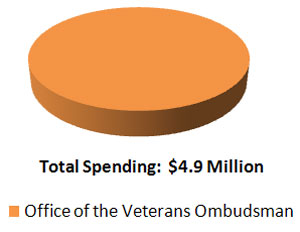
Strategic Outcome #4 Highlights
- 9,514 calls/emails/letters received in 2010-11
- 1,431 individuals served
- 1,823 new issues opened
- 2,449 issues addressed and closed (including 759 carried over from the previous year)
Financial Resources and Human Resources
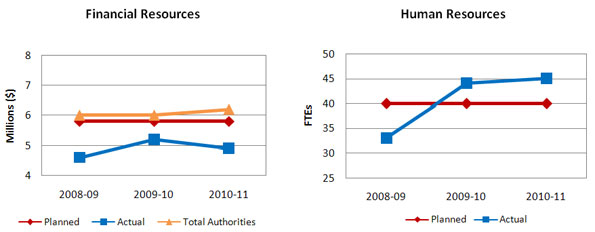
Program Activity 4.1 - Office of the Veterans Ombudsman independent review and recommendations on individual complaints and systemic issues
This program provides war service Veterans, Veterans and serving members of the Canadian Forces (Regular and Reserve), members and former members of the Royal Canadian Mounted Police, spouses, common-law partners, survivors and primary caregivers, other eligible dependants and family members, and other eligible individuals and representatives of these groups with the opportunity to request independent reviews of their complaints by an impartial individual who was not part of the original decision-making process.
The Veterans Ombudsman has the mandate to review and address complaints by Veterans, other individuals and their representatives arising from the application of the provisions of the Veterans Bill of Rights; to identify and review emerging and systemic issues related to programs and services provided or administered by the Department or by third parties on the Department's behalf that impact negatively on Veterans and other individuals; to review and address complaints by these individuals and their representatives related to programs and services provided or administered by the Department or by third parties on the Department's behalf, including individual decisions related to the programs and services for which there is no right of appeal to the Board; to review systemic issues related to the Board; and to facilitate access by Veterans and other individuals to programs and services by providing them with information and referrals.
| Planned Spending | Total Authorities | Actual Spending |
|---|---|---|
| 5.8 | 6.2 | 4.9 |
| Planned | Actual | Difference |
|---|---|---|
| 40 | 45 | (5) |
| Expected Results |
Performance Indicators |
Targets | Performance Status |
|---|---|---|---|
| Veterans and other individuals served by VAC are aware of and have access to Ombudsman Services. | Proportion of Veterans and other individuals served by VAC surveyed that feel they have access to and are aware of the services offered by Ombudsman. | 80% | Unable to assess* |
| Veterans, other individuals and the Department are aware of the issues and recommendations raised by the Ombudsman's Office. | Percentage of Veterans and other individuals served by VAC surveyed that are aware of the issues raised by the Ombudsman Office. | 80% | Unable to assess* |
| Percentage of observations and reports submitted, which have been acknowledged by the Department. | 80% | Exceeded |
Performance Summary and Analysis
Over the past fiscal year, the Office of the Veterans Ombudsman provided information, referrals and interventions on behalf of Veterans to ensure they receive the services, benefits and support they needed. The Office began the fiscal year with 759 ongoing issues. During the fiscal year an additional 1,823 issues were opened, resulting in a total of 2,582 issues. Of those, 2,449 were addressed and closed.
The Ombudsman, through his early intervention team, was able to identify several systemic issues that were found to affect larger groups of Veterans. These problems were pursued with the Department and as a result, many more Veterans were able to access required benefits and services
The Office developed an electronic tool to enable staff to determine the benefits and services available to individuals based on their specific type of service (i.e., still serving Canadian Forces member, Second World War Veteran or Survivor, Merchant Navy Veteran, RCMP former member, etc.). The OVO recognized that this tool had practical applications for both Veterans Affairs Canada and the Canadian public, and accordingly began sharing this tool with the Department.
The OVO continued to work diligently on its investigations throughout 2010-11 and expects to publish a report on its findings related to the Veterans Independence Program in 2011–12. In addition, research on the departmental adjudication process was completed. Due to the complexity of the issue, consultation over the findings will continue in the next fiscal year prior to publication.
The OVO also held three town hall meetings in Cornwall (Ontario), Lethbridge (Alberta) and Edmonton (Alberta), as part of an initiative to involve Veterans. Other venues, such as a public consultation Web page increased awareness and provided an open forum for individuals and Veterans and their families to contribute to and shape the work of the OVO.
Lessons Learned
What worked well
2010-11 was a transition year for the OVO, with much work completed to reorganize and restructure the office. Investments were also made to put administrative and operational procedures in place to provide a disciplined approach to administration and operations.
The Veterans Ombudsman Advisory Committee was also restructured to support a new approach, and to ensure that a broad range of views and experiences were reflected on the Committee. There are now three categories of membership: six military Veterans' representatives and one RCMP Veteran; three professional advisors; and affiliate members comprised of individuals with varied areas of expertise and experience. This new advisory team will assess the impact of changes to programs and services proposed by Veterans Affairs Canada and select issues for systemic reviews.
The office also identified three systemic investigations to be carried out in the next fiscal year. The first one will focus on families, the second on mental health and the third on long-term care services.
What could be improved
The OVO strives to continuously improve all facets of its operations by reviewing performance measurements against production and service delivery. This includes putting more emphasis on its quality assurance framework, updating the telephone system to better respond to the demand from our stakeholders, and carrying out a full review of workload processes and procedures to improve services to Veterans and their families.
Program Activity 5.1 – Internal Services
Sub Activities
- Governance and Management Support
- Resource Management Services
- Asset Management Services
Internal Services are groups of related activities and resources that support the needs of programs and other corporate obligations of an organization. These groups are: Management and Oversight Services; Communications Services; Legal Services; Human Resources Management Services; Financial Management Services; Information Management Services; Information Technology Services; Real Property Services; Materiel Services; Acquisition Services; and Travel and Other Administrative Services.
Internal Services include only those activities and resources that apply across an organization and not to those provided specifically to a program.
Program Activity 5.1 Snapshot
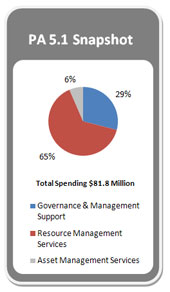
| Planned Spending | Total Authorities | Actual Spending |
|---|---|---|
| 84.7 | 87.3 | 81.8 |
| Planned | Actual | Difference |
|---|---|---|
| 799 | 753 | 46 |
Performance Summary and Analysis and Lessons Learned
What worked well
As required by the Internal Audit Policy, the Chief Audit Executive provided an independent annual report to the deputy head on the adequacy and effectiveness of risk management, control and governance processes within the Department. The November 2010 report concluded that great progress had been made in improving the risk management policies and practices of the Department. In August 2010, a Review of the Adequacy of Corporate Risk Management was initiated to assess VAC's Risk Management Framework. The results of this review will assist in implementing changes to VAC's risk management policies and practices.
VAC continued to be a strong supporter of the Public Sector Leadership Development Program, approving five employees to participate from each of the nine cohorts. The knowledge and skills acquired benefitted both the individuals and the organization by building capacity for strong and innovative leadership.
VAC's internal audit function continued to demonstrate a value-added contribution to strengthening risk, control and governance processes as evidenced by strong MAF ratings on the effectiveness of internal audits and the quality and use of evaluations. To ensure a high quality of service to Veterans and other individuals, activities were actively promoted to help address weaknesses in the Department's performance.
In 2010-11, the Department completed an Integrated Human Resource and Business Planning process to identify human resource requirements, including core skills and official language requirements. This was done to equip the current workforce with the necessary skills to support the Department's strategic priorities and provide VAC with a three-year human resource strategy to support its future service delivery model.
The Department also introduced quarterly reporting to monitor and track its progress in the delivery of programs and services. Early detection of problem areas enabled program managers to make informed decisions and implement corrective actions where necessary, to ensure that programs are delivered within plans, timelines and budgets.
What could be improved
During 2010-11, VAC faced significant challenges as a result of departmental privacy breaches. While the Department has since made progress in developing, promoting and implementing its security practices, work is still required in the areas of Management of Information Technology Security and Business Continuity Planning.
The Department noted the need to improve its annual forecasting methodology in two areas: to provide more accurate forecasts related to programs and services; and to ensure that long- term care per diem expenditures are based on acceptable accounting and financial management and control principles and practices.
The Head of Evaluation reported on the state of performance measurement of programs (tabled in November 2010), outlining the need for a stronger corporate commitment to support all related performance measurement activities.
